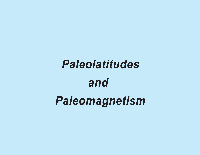|
|
2.1: Here are teaching slides for "Paleolatitudes
and Paleomagnetism".
You can see a full-size version by clicking on the thumbnail. You can then
download that slide individually
by simply dragging it to your desktop.
|
|
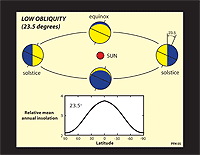 | 2.2:
Meridional (pole-to-equator) variation in relative mean annual insolation
for a planet
with an orbital obliquity of 23.5 degrees (e.g., present Earth).
|
|
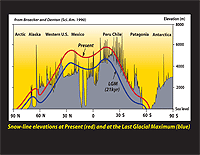 | 2.3:
Average snowline elevations from the Arctic to the Antarctic along the
American Cordillera at present (red line) and during the Last Glacial Maximum
(blue line) approximately 22,000 years before present (after Broecker & Denton,
1990).
|
|
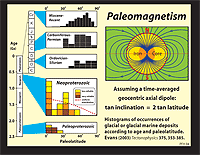 | 2.4:
Histograms of occurrence of glacial or glacial-marine deposits according
to age and
paleolatitude (after Evans, 2003). Relation between time-averaged paleomagnetic
inclination and paleolatitude, assuming a geocentric axial dipole.
|
|
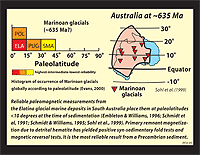 | 2.5:
Reconstruction of cratonic Australia at the time of the younger Cryogenian
(Marinoan)
glaciation (635 Ma), based on reliable paleomagnetic data from the Elatina
glacial marine deposits in South Australia. Note that all Marinoan glacial
deposits in Australia appear to have been deposited within 20 degrees of
the paleoequator.
|
|
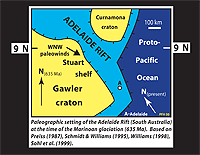 | 2.6:
Paleogeographic setting of the Adelaide Rift system of South Australia
at the time of the
Marinoan glaciation (ca 635 Ma). Yellow, stable platforms; light blue,
areas of crustal stretching and subsidence; dark blue, ocean basin.
|
|
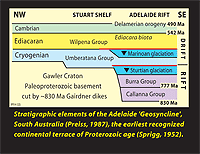 | 2.7:
Simplified stratigraphy of the Adelaide Geosyncline of South Australia.
|
|
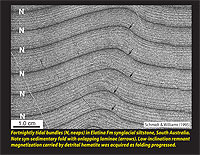 | 2.8:
Tidal rhythmite (reddish silstone) with syn-sedimentary fold in the glacial-marine
Elatina Formation (Marinoan) at Pichi Richi Pass, South Australia. Primary
natural remnant magnetization (NRM) carried by detrital hematite passes
the fold test (minimum data disperson after ~65% unfolding). The finding
indicates that glaciers reached sea-level close to the equator.
|
|
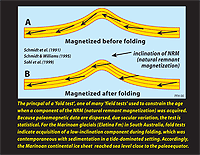 | 2.9:
The principle of a “fold test” as a means of constraining the
age of natural remnant magnetization.
|
|
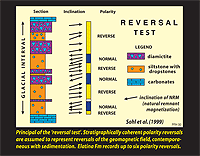 | 2.10:
The principle of a “reversal test” as a means of constraining
the age of natural remnant magnetization.
|
|
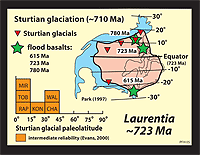 | 2.11:
Reconstruction of cratonic Laurentia (North America-Greenland-NW Scotland)
near the time
of the older Cryogenian (Sturtian) glaciation (ca 710 Ma), based on paleomagnetic
data from the 723-Ma Franklin igneous suite (basalt lavas, dikes and sills).
Note that all Sturtian glacial deposits in Laurentia appear to have been
deposited within 20 degrees of the paleoequator.
|
|
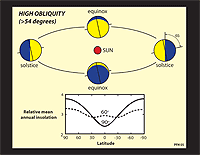 | 2.12:
Meridional variation in relative mean annual insolation for a planet with
orbital
obliquities of 60 and 90 degrees. Relatively strong polar insolation stems
from perpetual high-incident summer radiation. High seasonality is found
at all latitudes.
|
|
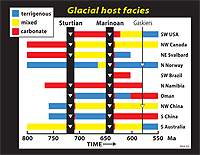 | 2.13:
Nature of host strata (carbonate, mixed, or terrigenous) for Neoproterozoic
glacial deposits (inverted triangles) in different regions.
|

